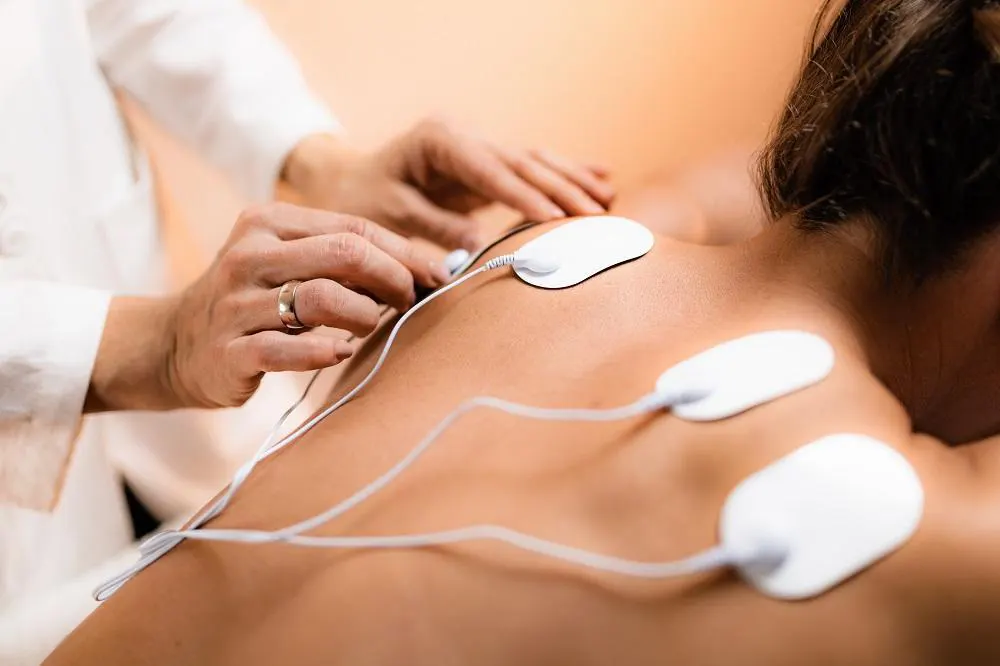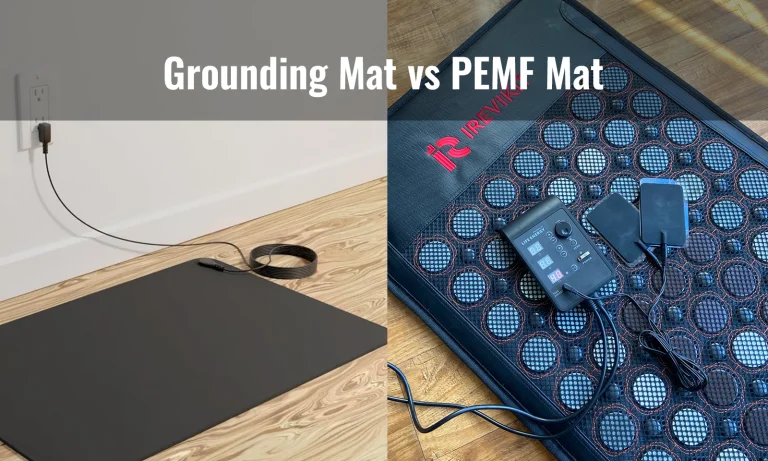What is TENS (Transcutaneous Electrical Nerve Stimulation)?
What is transcutaneous electrical nerve stimulation (TENS)?
Transcutaneous electric nerve stimulation (TENS) is a non-invasive pain-reduction therapy that involves using a portable device (TENS unit) that applies slight electrical pulses on painful areas of the body. These electrical pulses flood the nervous system, reducing its ability to transmit pain signals from the spinal cord to the brain. The electrical pulses also cause the body to produce natural pain relievers called endorphins.
TENS can stimulate the sensory nerves in a direct, localized way, which activates various natural pain-relieving mechanisms within the body. TENS therapy provides a simple, safe, drug-free, and effective solution for people who suffer from back and shoulder pain, tendonitis, nerve pain, sports injuries, arthritis, fibromyalgia, diabetic neuropathy, menstrual pain, and other conditions.
How Does TENS Therapy Work?
The brain works to ensure there is a balance between neurons that turn off and on pain. In normal circumstances, there is an even balance of these neurons so that no pain is felt.
Those dealing with chronic pain have an imbalance between these neurons and the cells of these neurons that turn on pain are participating in more activity than the neurons used to turn off pain.
When using a TENS unit, electrical impulses flood the nervous system and reduce its ability to transmit pain signals to the brain.
These electrical impulses can release endorphins and other substances (serotonin and natural opioids) in the brain to stop pain signals in the brain.
Furthermore, TENS works to create a better balance of the sensation of pain and promote a release of chemicals that turn off pain.
- TENS delivers direct, localized stimulation.
- Powerful, deep muscle stimulation, ideal for chronic and acute pain.
- TENS provides faster, localized treatment for short-term pain relief.
- TENS offers precise and effective therapy for various types of pain.
- When used in conjunction with each other, TENS, PEMF, Red and Infrared Light Therapy provide an even greater benefit.
- It combines advanced pain relief with ease of use, perfect for home and clinical settings.
Research History of TENS Therapy
TENS operates according to the “gate control” theory of pain. In 1965, a pair of researchers (Ronald Melzack and Patrick Wall) discovered the human body contains two types of nerve fibers: large and small. Pain is transmitted over small nerve fibers, while sensations regarding movement, pressure, and touch are transmitted over large ones.
Contrary to what many believe, our brains do not process all the information absorbed by our nervous system. Our neurological receptors actively select which signals to process and which to ignore. For instance, when our fight or flight response is activated, our brains often block painful stimuli until we’ve escaped to safety. Because electrical signals travel faster over thick nerve fibers, Melzack and Wall theorized that the brain would prioritize them over signals sent over small fibers. This is why rubbing a bruised elbow makes us feel better. Stimulating large fibers blocks pain signals.
When a patient receives TENS, electrodes attached to their skin deliver electrical impulses directly to their nerves. This sudden surge of energy overrides pain signals. At the same time, the current stimulates production of dopamine and endorphins ‒ the body’s natural painkillers.
As a result, patients receiving TENS not only report less pain, but also a greater sense of well-being and relaxation. But while TENS provides quick relief from acute and chronic pain, such as arthritis, fibromyalgia, and muscle strain, its effects rarely last longer than 24 hours. In some cases, pain returns as soon as the unit is switched off. Fortunately, TENS devices are designed for use at home as well as clinical settings, allowing patients suffering from serious pain to seek relief at all hours of the day and night.
Most experience acute or chronic pain at some point, and finding the least invasive product with minimal to no side effects can be challenging. Fortunately, science has discovered the benefits of transcutaneous electrical nerve stimulation – more commonly known as TENS therapy.
TENS therapy is one of the 6 powerful healing modalities included in our TheraPro PEMF multi-therapeutic device. Please read below if you’re considering adding TENS to your healing routine.
Potential Benefits of TENS Therapy
- Highly effective for pain relief and is a natural pain reliever
- Pain management
- Promote tissue healing
Increase muscle strength
Maintaining and regaining muscle activity
Increases endorphins - Helps reduce the need for pain medications
- A non-invasive therapy
- Increases circulation to the area
- Reduces muscle tension
- Reduces muscle spasms
- Used for nerve retraining to support the nervous system
- Less pain means a calm nervous system and the ability to relax
- Improves ability to heal
- Reduces anxiety and depression
- Improved sleep
- Promotes relaxation
- Improved range of motion
Who is TENS therapy for?
Research has show that TENS therapy can help acute or chronic pain sufferers with many of the following:
- Healing from an injury
- Osteoarthritis (disease of the joints)
- Fibromyalgia (full body pain)
- Tendinitis (inflammation or irritation of tendons)
- Labor Pain and Menstrual Pain
- Neuropathy (damage to nerves that connect the brain/spinal cord to the body)
- Low Back Pain
- Peripheral artery disease (hardening of the arteries that circulate blood to the body)
- Joint Pain
A TENS unit is helpful for most, but not for everyone.
Those who should NOT use a TENS unit are:
Although it is safe for most people, experts recommend that some groups of people avoid TENS treatment unless a doctor advises its use.
This recommendation applies to the following people:
- Pregnant women: Pregnant women should avoid using TENS in the abdominal and pelvic regions.
- People with epilepsy: Applying electrodes to the head or neck of people with epilepsy may induce seizures.
- People with heart problems.
- People with a pacemaker or another type of electrical or metal implant.
- Anyone with an implantable device such as a cardioverter, defibrillator, neurostimulator, bone growth stimulator, or indwelling blood pressure monitor
- Those who are pregnant
- Those who have deep vein thrombosis or thrombophlebitis
- Those with a bleeding disorder or recent or actively bleeding tissue
- Those with cancer or a history of cancer should not apply electrodes to areas of the body where there is suspected or known cancer.
- Those with epilepsy should not apply electrodes to the head, neck, or shoulders.
- Those with heart disease, heart failure, or arrhythmias should not apply a TENS unit to the chest
- Talk with your healthcare provider if you have cancer, diabetes, epilepsy, cognitive impairment, or are pregnant
TENS Unit for Back Pain
How to Use IREVIKIT TENS Unit
- Place the two adhesive pads around the area of pain. Keep in mind the farther the pads are from the painful area, the higher the intensity level of electrical currents needed to achieve desired results.
- The user can adjust the intensity, frequency, and duration of the electrical impulses based on his or her pain level.
- There are 29 levels to choose from, though you will not see numbers on the dial. Keep it at a level that feels right for you and increase it slowly from weak to strong as needed. You may try different levels to see which works best for you.
- Do not use TENS on your head, face or throat; swollen, red, infected, or inflamed skin; on or near cancerous lesions, open wounds or rashes, or skin that does not have normal sensation.
- Do not use it directly on your backbone or on the front and back of your chest at the same time.
Whether you’re looking to relieve pain or simply improve nerve function and blood flow, TENS technology can help.
You can experience this life-changing therapy in the comfort of your home with our IREVIKIT PEMF multi-therapeutic pad. AND you can combine it with red light, far infrared, gemstone tech, PEMF, grounding, and more!
As always, please check with your doctor or practitioner before starting a new therapy or adding new technology to your healing routine
Why Are TENS and PEMF Often Confused?
As mentioned, TENS and PEMF are two frequently used modalities that are applied to promote pain relief. With this similar therapeutic goal, many often confuse the two and fail to differentiate their specific strategies for pain relief and underlying mechanisms of action. Each targets pain from a unique approach and affects different bodily systems and structures. TENS, the first of the two modalities, works through the application of electrical currents whereas PEMF therapy employs applied electromagnetic fields. While TENS temporarily affects the user’s pain perception, PEMF therapy actually works at the cellular level to promote tissue healing, thereby addressing pain as both a symptom as well as the underlying cause.
While TENS and PEMF therapy may share some common ground in their treatment goals, they should be differentiated in a number of important ways. In general, TENS provides faster, more localized treatment that focuses on short-term pain relief while PEMF therapy provides a more holistic approach that actually stimulates the body’s healing processes. Follow along as we uncover the inner workings of each to help you find the most appropriate therapy for your treatment goals.
Possible side effects of TENS
It is safe for most people to use a TENS unit, and they will not usually experience any side effects. However, the electrical impulses that a TENS unit produces may cause a buzzing, tingling, or prickling sensation, which some people may find uncomfortable.
- Skin irritation at the electrode sites
- Allergic rash from electrodes, adhesive, or gel
- Electrical skin burns at the electrode sites
- Breakdown of a pacemaker or another implanted device







